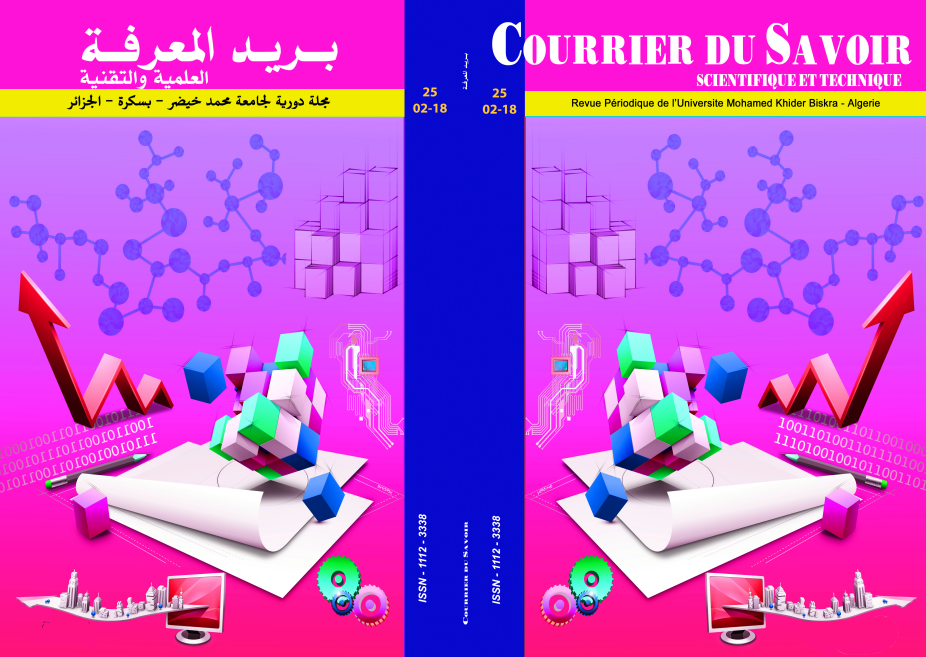PHYTOTOXICITE DES EXTRAITS DE TROIS ESPECES VEGETALES SUR LE BLE DUR ET SUR KOCHIA SCOPARIA: ADVENTICE ENVAHISSANTE DES PERIMETRES AGRICOLS DANS LA WILAYA DE BISKRA
Résumé
Les plantes adventices envahissantes causent d’importants dégâts aux cultures. Un cas est signalé dans la wilaya de Biskra, c’est Kochia scoparia (L.) Schrad., une espèce problématique dans quelques périmètres agricoles de la Wilaya de Biskra. Ganida, ainsi nommée par les habitants de la région est une espèce envahissante des différentes cultures. La découverte d’un herbicide naturel peut réduire les impacts préjudiciables des traitements chimiques à l’environnement. Dans le but de rechercher des produits d’origine végétale qui peuvent avoir une action herbicide, trois espèces végétales (Ailanthus altissima (Mill.) Swing., Nerium oleander L. et Peganum harmala L.) ont été choisies pour tester leurs potentiel allélopathique sur la germination des graines et le développement des plantules du blé dur et de K. scoparia. Trois extraits de différentes concentrations (1%, 3% et 5%) ont été préparés à partir des feuilles de chaque espèce. Ces extraits sont testés in vitro à une température de 22,5 ±1°C, ils sont également testés sur des graines du blé dur variété Waha. Statistiquement, l’effet inhibiteur des extraits surtout ceux de P. harmala, est hautement significatif, il se manifeste beaucoup plus sur le développement des plantules de Kochia, surtout la partie racinaire. L’inhibition est supérieure à 91% pour les 3 concentrations. Pour le blé, la germination n’est pas affectée par les extraits des trois plantes (l’inhibition est inférieur à 6%) et une stimulation du développement aérien est aussi observée, elle peut atteindre 47%. En général, l’inhibition est importante lorsque la concentration des extraits est élevée, cette augmentation n’est pas proportionnellement similaire pour les 3 espèces.
Mots clES: Kochia scoparia, Peganum harmala, Ailanthus altissima, Nerium oleander, allélopathie, Biskra.
ABSTRACT
Invasive weeds cause significant crop damage. A case is reported in the Wilaya of Biskra, it is Kochia scoparia (L.) Schrad., a problematic species in some agricultural areas of the Wilaya of Biskra. Ganida, so named by the locals is an invasive species of different cultures. The discovery of a natural herbicide little to reduce adverse impacts to the environment. In order to search for natural plant products that can have an herbicidal activity, three species (Ailanthus altissima (Mill.) Swing., Nerium oleander L. and Peganum harmala L.) were selected to test their allelopathic potential on seed germination and seedling development of Kochia scoparia. Three extracts of different concentrations (1%, 3% and 5%) are prepared from the leaves of each species. These extracts were tested in vitro at a temperature of 22.5 ± 1 °C, they were also tested on seeds of durum wheat variety Waha. Statistically, the inhibitory effect of extracts, especially those of P. harmala, is highly significant; it is much more evident on the development of Kochia seedlings, especially the root. The inhibition is greater than 91% for the 3 concentrations. For wheat, germination is not affected by the extracts of the three plants (the inhibition is less than 6%) and a stimulation of the aerial development is also observed, it can reach 47%. In general, inhibition is important when the concentration of the extracts is high, this increase is not proportionally similar for the 3 species. have been met for the first time in the National Park area. The majority of the found species have important and diverse roles.
Keywords: Kochia scoparia, Peganum harmala, Ailanthus altissima, Nerium oleander, allelopathy, Biskra.


